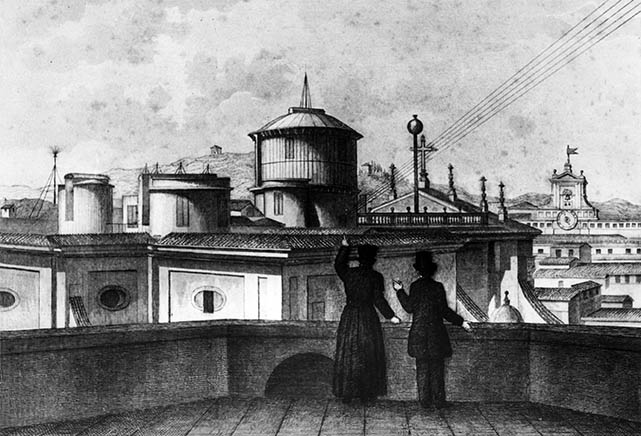Roman College Observatory

The Roman College was restored to the Jesuits in the early 19th century. In 1850, Fr. Angelo Secchi SJ was named the director of the Roman College Observatory. Two years later, with the encouragement of Father General Roothaan, Secchi revived an old idea of Roger Boscovich to transfer the observatory to the top of the Church of St. Ignatius. The Church had robust walls and four immense pillars originally designed to support a dome which was never built. Thanks to funding from Pope Pius IX, in a very short time the new Observatory was erected following the design of the architect Angelo Vescovali (1826-1895).
Secchi’s assistant, Father Rosa, had been able to use an inheritance to acquire a Merz equatorial telescope with a 24 cm aperture and 4.35 meter focal length, one of the highest quality instruments of its time. The Roman College Observatory, equipped with this Merz, a Cauchoix telescope, and an Ertel meridian telescope, soon became one of the first astrophysical observatories in Europe.
Secchi’s assistant, Father Rosa, had been able to use an inheritance to acquire a Merz equatorial telescope with a 24 cm aperture and 4.35 meter focal length, one of the highest quality instruments of its time. The Roman College Observatory, equipped with this Merz, a Cauchoix telescope, and an Ertel meridian telescope, soon became one of the first astrophysical observatories in Europe.
This image shows Father Secchi’s observatory on top of the Church of St. Ignatius as seen from the tower of Calandrelli (from the Tipografia della Pace, Rome, 1877). The three turrets housed, from left to right, the Cauchoix refractor; the Ertel meridian telescope; and ( in the center of the image) the Merz equatorial telescope. To its right, in front of the cross, one can see a large ball at the top of a rod. This ball was dropped to indicate to a gunner at Castel Sant’Angelo to give the noon signal by firing a blank cannon shot. The noon cannon was transferred to the Janiculum in 1904; the tradition of the cannon firing at noon continues to this day.
